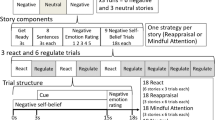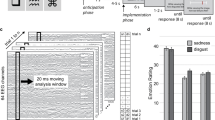Abstract
Adaptive self-regulatory responses to negative events are associated with good mental health, social functioning, and physical health. Two forms of emotion regulation that have received attention within the context of anger are cognitive reappraisal and expressive suppression. Research suggests that greater heart rate variability (HRV) is a physiological indicator of adaptive emotion regulation and decreased mental load. In the present experiment, we recorded HRV while 131 undergraduate women viewed an anger-inducing video of a fellow student arguing for a position counter to that of the participant on an important political issue. Immediately prior to viewing, participants were instructed to reappraise, suppress their emotions, or simply watch the video as normal. Participants in the reappraisal condition showed increased HRV whereas those in the suppression and control condition showed no such increase. These results provide support for increased HRV as a biological correlate of adaptive emotion regulation. One implication is that cognitive reappraisal might afford greater autonomic flexibility when an individual is confronted with anger-inducing events.


Similar content being viewed by others
Notes
Participants also completed a second manipulation check item for reappraisal (i.e., “I thought about the positive aspects of the event”) but this did not form a reliable composite with the “objective perspective” item (α = .53). We therefore relied on the latter item as it accurately captures the essence of cognitive reappraisal.
References
Aasman, J., Mulder, G., & Mulder, L. J. (1987). Operator effort and the measurement of heart rate variability. Human Factors, 29, 161–170.
Appelhans, B. M., & Luecken, L. J. (2006). Heart rate variability as an index of regulated emotional responding. Review of General Psychology, 10, 229–240.
Balogh, S., Fitzpatrick, D. F., Hendricks, S. E., & Paige, S. R. (1993). Increases in heart rate variability with successful treatment in patients with major depressive disorder. Psychopharmacological Bulletin, 29, 201–206.
Beauchaine, T. (2001). Vagal tone, development, and Gray’s motivational theory: Toward an integrated model of autonomic nervous system functioning in psychopathology. Development and Psychopathology, 13, 183–214.
Berntson, G. G., Lozano, D. L., & Chen, Y.-J. (2005). Filter properties of root mean square successive difference (RMSSD) for heart rate. Psychophysiology, 42, 246–252.
Butler, E. A., Wilhelm, F. H., & Gross, J. J. (2006). Respiratory sinus arrhythmia, emotion, and emotion regulation during social interaction. Psychophysiology, 43, 612–622.
Epstein, E. M., Sloan, D. M., & Marx, B. P. (2005). Getting to the heart of the matter: Written disclosure, gender, and heart rate. Psychosomatic Medicine, 67, 413–419.
Fabes, R. A., & Eisenberg, N. (1997). Regulatory control and adults’ stress-related responses to daily life events. Journal of Personality and Social Psychology, 73, 1107–1117.
Friedman, H. S., & Booth-Kewley, S. (1987). The ‘‘disease prone personality”: A meta-analytic view of the construct. American Psychologist, 42, 539–555.
Goedhart, A. D., van der Sluis, S., Houtveen, J. H., Willemsen, G., & de Geus, E. J. C. (2007). Comparison of time and frequency domain measures of RSA in ambulatory recordings. Psychophysiology, 44, 203–215.
Goodie, J. L., Larkin, K. T., & Schauss, S. (2000). Validation of the polar heart rate monitor for assessing heart rate during physical and mental stress. Journal of Psychophysiology, 14, 159–164.
Gross, J. J. (1998). Antecedent- and response-focused emotion regulation: Divergent consequences for experience, expression, and physiology. Journal of Personality and Social Psychology, 74, 224–237.
Gross, J. J. (2001). Emotion regulation in adulthood: Timing is everything. Current Directions in Psychological Science, 10, 214–219.
Hadase, M., Azuma, A., Zen, K., Asada, S., Kawasaki, T., Kamitani, T., et al. (2004). Very low frequency power of heart rate variability is a powerful predictor of clinical prognosis in patients with congestive heart failure. Circulation Journal, 68, 343–347.
Hansen, A. L., Johnsen, B. H., & Thayer, J. F. (2003). Vagal influence on working memory and attention. International Journal of Psychophysiology, 48, 263–274.
Hosie, J. A., Milne, A. B., & McArthur, L. (2005). The after-effects of regulating anger and anger-related emotions on self-report ratings and behavior: Divergent consequences for men and women. Psychologia: An International Journal of Psychology in the Orient, 48, 288–305.
Jönsson, P., & Sonnby-Borgström, M. (2003). The effects of pictures of emotional faces on tonic and phasic autonomic cardiac control in women and men. Biological Psychology, 62, 157–173.
Kubzansky, L. D., Davidson, K. W., & Rozanski, A. (2005). The clinical impact of negative psychological states: Expanding the spectrum of risk for coronary artery disease. Psychosomatic Medicine, 67, S10–S14.
La Rovere, M. T., Pinna, G. D., Maestri, R., Mortara, A., Capomolla, S., Febo, O., et al. (2003). Short-term heart rate variability strongly predicts sudden cardiac death in chronic heart failure patients. Circulation, 107, 565–570.
Lane, R. D., McRae, K., Reiman, E. M., Chen, K., Ahern, G. L., & Thayer, J. F. (2009). Neural correlates of heart rate variability during emotion. Neuroimage, 44, 213–222.
Leon, I., Hernandez, J. A., Rodriguez, S., & Vila, J. (2009). When head is tempered by heart: Heart rate variability modulates perception of other-blame reducing anger. Motivation and Emotion, 33, 1–9.
Liao, D., Carnethon, M., Evans, G. W., Cascio, W. E., & Heiss, G. (2002). Lower heart rate variability is associated with the development of coronary heart disease in patients with diabetes—the atherosclerosis risk in communities (ARIC) study. Diabetes, 51, 3524–3531.
Mauss, I. B., Cook, C. L., Cheng, J. Y. J., & Gross, J. J. (2007). Individual differences in cognitive reappraisal: Experiential and physiological responses to an anger provocation. International Journal of Psychopathology, 66, 116–124.
Memedovic, S., Grisham, J. R., Denson, T. F., & Moulds, M. L. (2010). The effects of trait reappraisal and suppression on anger and blood pressure in response to provocation. Journal of Research in Personality, 44, 540–543.
Mendes, W. B. (2009). Assessing autonomic nervous system activity. In E. Harmon-Jones & J. S. Beer (Eds.), Methods in social neuroscience. New York, NY, USA: Guilford.
Nowlis, V. (1965). Research with the mood adjective checklist. In S. S. Tompkins & C. S. Izard (Eds.), Affect, cognition, and personality: Empirical studies. Oxford, UK: Springer.
Ochsner, K. N., & Gross, J. J. (2008). Cognitive emotion regulation: Insights from social cognitive and affective neuroscience. Current Directions in Psychological Science, 17, 153–158.
Penttilä, J., Helminen, A., Jartti, T., Kuusela, T., Huikuri, H. V., Tulppo, M. P., et al. (2001). Time domain, geometrical and frequency domain analysis of cardiac vagal outflow: Effects of various respiratory patterns. Clinical Physiology, 21, 365–376.
Porges, S. W. (2007). The polyvagal perspective. Biological Psychology, 74, 116–143.
Quartana, P. J., & Burns, J. W. (2010). Emotion suppression affects cardiovascular responses to initial and subsequent laboratory stressors. British Journal of Health Psychology, 15, 511–528.
Ray, D. R., Wilhelm, F. H., & Gross, J. J. (2008). All in the mind’s eye? Anger rumination and reappraisal. Journal of Personality and Social Psychology, 94, 133–145.
Richards, J. M., & Gross, J. J. (2000). Emotion regulation and memory: The cognitive costs of keeping one’s cool. Journal of Personality and Social Psychology, 79, 410–424.
Sloan, D. M., & Epstein, E. M. (2005). Respiratory sinus arrhythmia predicts written disclosure outcome. Psychophysiology, 42, 611–615.
Stein, P. K., & Kleiger, R. E. (1999). Insights from the study of heart rate variability. Annual Review of Medicine, 50, 249–261.
Stemmler, G. (1997). Selective activation of traits: Boundary conditions of the activation of anger. Personality and Individual Differences, 22, 213–233.
Suls, J., & Wan, C. K. (1993). “The relationship between trait hostility and cardiovascular reactivity: A quantitative review and analysis. Psychophysiology, 30, 615–626.
Swain, A., & Suls, J. (1996). Reproducibility of blood pressure and heart rate reactivity: A meta-analysis. Psychophysiology, 33, 162–174.
Tattersall, A. J., & Hockey, G. R. (1995). Level of operator control and changes in heart rate variability during simulated flight maintenance. Human Factors, 37, 682–698.
Thayer, J. F., & Lane, R. D. (2000). A model of neurovisceral integration in emotion regulation and dysregulation. Journal of Affective Disorders, 61, 201–216.
Thayer, J. F., & Lane, R. D. (2009). Claude Bernard and the heart–brain connection: Further elaboration of a model of neurovisceral integration. Neuroscience and Biobehavioral Reviews, 33, 81–88.
van der Meij, L., Buunk, A. P., Almela, M., & Salvador, A. (2010). Testosterone responses to competition: The opponent’s psychological state makes it challenging. Biological Psychology, 84, 330–335.
Wranik, T., & Scherer, K. R. (2010). Why do I get angry? A componential appraisal approach. In M. Potegal, G. Stemmler, & C. Spielberger (Eds.), International handbook of anger: Constituent and concomitant biological, psychological, and social processes (pp. 243–266). New York, NY, USA: Springer.
Acknowledgments
Funding was provided by an Australian Research Council Discovery Project grant to all three authors. Thank you to Carolyn Lorian and Sonja Memedovic for help with data collection and analyses.
Author information
Authors and Affiliations
Corresponding author
Rights and permissions
About this article
Cite this article
Denson, T.F., Grisham, J.R. & Moulds, M.L. Cognitive reappraisal increases heart rate variability in response to an anger provocation. Motiv Emot 35, 14–22 (2011). https://doi.org/10.1007/s11031-011-9201-5
Published:
Issue Date:
DOI: https://doi.org/10.1007/s11031-011-9201-5




